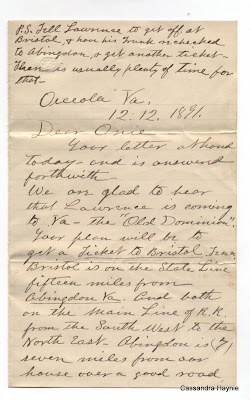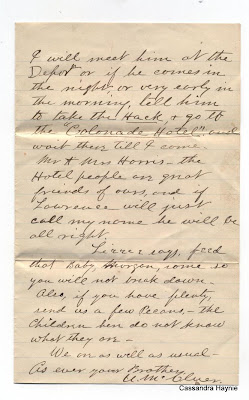
We have one family name which can be traced back in history much further than any other surname (to the 12th century & earlier), and that is Wyche. This was the maiden name of Poppa Henry's grandmother, Elizabeth Jenkins Wyche Tillett.
The Wyches even had a saint in the family. In the 13th century, the brother of one of our direct ancestors was Richard de Wyche, Bishop of Chichester & Saint Richard in the Roman Catholic Church. The name Wyche is supposed to mean salt spring. It is also short for the town of Droitwich, which is located in an area of Worcestershire where salt has been extracted since ancient times.
Our 17th century emigrant ancestor was Henry Wyche II (1648-1714). He was born in Surrey County, England, traveled to America in the late 1670's, and settled in Surry County, Virginia. Henry's grandfather was Richard Wyche (1554-1621), Gentleman and Mercer; Richard was a shipowner, merchant, and one of the charter directors of the English East India Company.
According to a Wikipedia entry, Richard was also "among the adventurers of the Muscovy Company," chartered in 1555 and the first major English joint-stock trading company. It monopolized English trade with Russia for about 150 years and survived as a trading company until the Russian Revolution of 1917, after which it became a charity. I just found this information today...I am moved that this ancestor of ours was involved, early on, with a private organization which reportedly has sustained a 450 year history, or the entire period during which the twelve or so additional generations of this man's descendants have lived...The Wikipedia item on Richard Wyche says that several locations in the Arctic region were named after him:
http://en.wikipedia.org/wiki/Richard_Wyche_(merchant)Richard Wyche married Elizabeth Saltonstall, daughter of Sir Richard Saltonstall, Member of Parliament and Lord Mayor of London. [She had a first cousin Sir Richard Saltonstall who established a Massachusetts colony in 1630.] The couple had many sons; the Honorable Nathaniel Wyche lived in India and was President of the East India Company in the late 1650's. Another son was the Right Honorable Sir Peter Wyche, Ambassador to Constantinople (Ottoman Empire), who married Jane Meredith. Their children included (another) Sir Peter Wyche, Sir Cyril Wyche, and Lady Jane (Wyche) Granville. Rt. Hon. Sir Peter Wyche was one of the Chancellors of Oxford University, and his sons Sir Cyril and Sir Peter were among the founding members of the British Royal Society. Lady Jane was Countess of Bath and Lady of the Bedchamber to Henrietta Maria of France, Queen Consort of King Charles I.*
Sir Cyril Wyche, scholar and longtime Member of Parliament, was a first cousin of our ancestor, Henry Wyche II. His portrait, whose image is shown here, hangs in the National Portait Gallery of London. Henry was the son of Henry Wyche (1604-1678), Rector of Sutton in Surrey, England, and his wife Ellen Bennett, daughter of Ralph Bennett, Esquire.
According to the Tillett book, "one of the oldest streets in the old walled city of London proper was Wyche St." Today, there is a Wyche St. in Henderson, North Carolina (Vance County), which was named after either James Wyche or his sister Sally Wyche Reavis.
There is a new, interactive website developed by and for descendants of James & Pamela Wyche of North Carolina:
http://www.benwychefamily.com/*I added the above paragraph about Richard Wyche's family to expand the short Wikipedia article on him, since this information was documented in the
James Wyche Family History, a section of
The Reverend John Tillett Family History, published in 1955.
The Wyche section of the Tillett book is dedicated to Clarence A. Wyche, a first cousin of our great-grandfather Henry A. "Gus" Tillett. Clarence, who died in 1947, did most all of the research about the early ancestry of the Wyches. Charles W. Allison, the book's compiler, was another first cousin of Gus and Clarence, being a son of Jeannette Tillett Allison (Gus' big sister who looked after him following their mother's death).




-743221.jpg)
-754797.jpg)
-727324.jpg)
-728326.jpg)



























